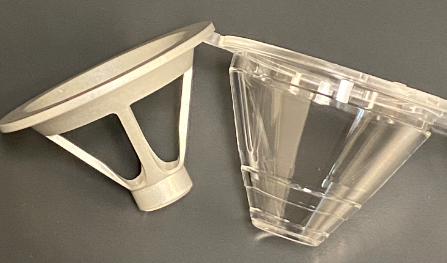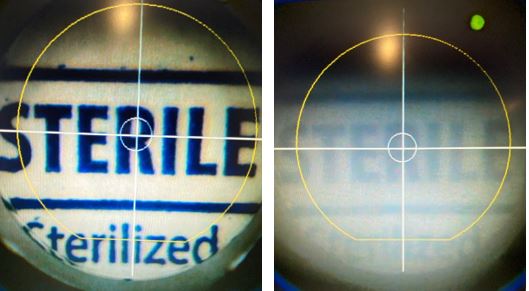Clinical Alert
Increased Risk of Femtosecond Laser Flap Complications with Patient Mask Use
Issued on July 2, 2020 by the Refractive Surgery Clinical Committee of the American Society of Cataract and Refractive Surgery
Because of the increased precautions being taken with COVID-19, many refractive surgery centers are recommending that surgical patients wear masks during their LASIK procedure. A recently reported phenomenon of fogging on the femtosecond laser applanation cone has been described, presumably due to warm, humid patient breaths escaping from around the mask.
Some of the applanation cones are completely enclosed (see applanation cone on the right in Figure 1) and therefore should not pose a problem. However, applanation cones which are open (see applanation cone on the left in Figure 1) are at higher risk for fogging, specifically on the top surface of the applanation cone (and not the bottom surface that actually contacts the cornea). The images below in Figure 2 show an open applanation cone with a clear and focused image, and the same applanation cone that turns foggy after a technician breathed on the cone.
This fogging phenomenon on the top surface of the cone can pose a significant issue with decreased surgeon visualization and attenuation of the laser beam, resulting in an increased risk of flap complications from incomplete and/or irregular laser dissection. Maneuvers to help prevent build-up of this condensation on the applanation cone include sliding the mask away from the applanation cone and/or securely taping the entire superior edge of the mask. If fogging is noted prior to applanation of the cornea, the mask position and taping should be re-examined and adjusted appropriately. If the fogging is noted after corneal applanation, the procedure should be aborted and the applanation cone should be replaced before proceeding with femtosecond flap creation.
Awareness, recognition and prevention of this fogging phenomenon related to patient mask use during femtosecond laser flap creation will reduce and hopefully eliminate the aforementioned flap complications.
Figure 1: Femtosecond laser applanation cones with an open iFS cone on the left and a closed Wavelight cone on the right.


Figure 2: The left image shows a clear and focused image with an open applanation cone, and the right image shows a foggy image with the same applanation cone after a technician has breathed on the cone.



The ASCRS Refractive Surgery Clinical Committee
This Clinical Alert is also available for download as a PDF and will be published in a future issue of EyeWorld magazine.



